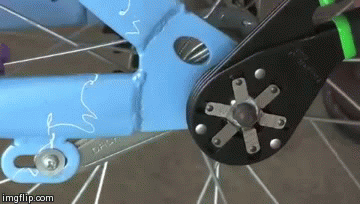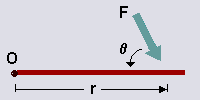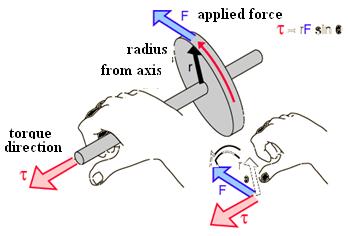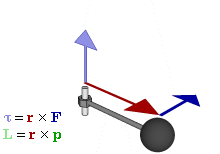|
|
| Line 1: |
Line 1: |
| == Why Energy is conserved ==
| |
|
| |
| The main idea of this page is to elaborate a little more on why energy is conserved and to understand it is a more simplified way. The thought about the fact that energy is neither created nor destroyed can be a mind boggling one simply because energy always seems to be coming from somewhere, so where does it go? The main idea behind why energy is conserved and neither created or destroyed is that it is just transferred to other forms. The first law of Thermodynamics states that the amount of energy in the universe is a constant, fixed amount. Is doesn’t go away and it doesn’t appear randomly.
| |
|
| |
| ===A Mathematical Model===
| |
|
| |
| The mathematical equations that are used to model this topic include many different equations, but they all relate back to the energy principle, ΔEsystem = WSurr +Q. W is the work cone by the surroundings and Q is the thermal energy. The change in energy will be always zero because energy is transferring to other forms of energy within the system or surroundings. Other Important equations include:
| |
| K = ½mv2, ΔUg = mgΔh, E = K + U, Ei = Ef, Ki + Ui = Kf + Uf, W = F̅Δs cos θ.
| |
|
| |
| ===A Computational Model===
| |
| This video shows how energy in conserved in a variety of situations.
| |
| http://study.com/academy/lesson/first-law-of-thermodynamics-law-of-conservation-of-energy.html
| |
|
| |
| ==Examples==
| |
|
| |
| ===Simple===
| |
|
| |
| Question: State the law of conservation of energy and explain the law by taking an oscillating simple pendulum as an example.
| |
|
| |
| Answer: The law of conservation of energy says that energy can neither be created nor destroyed but can be transformed from one form to another.
| |
| In the case of the simple pendulum when the bob is as far to the left as it can be, it has maximum potential energy as it is raised with respect to the mean position, but its kinetic energy is zero as the bob stops oscillating for a fraction of a second before moving towards the right. When the bob reaches the mean position, it has a zero potential energy but maximum kinetic energy (maximum velocity too). When the bob of the pendulum swings to extreme right, it has the maximum potential energy but zero kinetic energy.
| |
| ===Middling===
| |
| Question: A nail becomes warm when it is hammered into a plank. Explain why.
| |
|
| |
| Answer: A raised hammer has potential energy due to its position above the ground, gravity acts as acceleration. When the hammer comes down and strikes the head of the nail, the potential energy is transformed into kinetic energy. If we continue hitting the nail to secure it, the kinetic energy of the hammer is transferred to the molecules of the material of the nail. The heat content of the body is the total energy that the body possesses (Q in the equation above). As the heat content of the body increases, the nail becomes warm.
| |
| ===Difficult===
| |
| Question:
| |
| A stone of mass 10 g placed at the top of a tower 50 m high is allowed to fall freely. Show that law of conservation of energy holds good in the case of the stone.
| |
| http://images.tutorvista.com/contentimages/science/CBSEIXSCIENCE/Ch146/images/img179.jpeg
| |
| Answer: In this case we have to prove that total energy at A, B and C is the same.
| |
| Height = 50 m
| |
| Potential energy at A = mgh
| |
| = 0.01 x 9.8 x 50
| |
| = 0.01 x 98 x 5
| |
| = 4.9 J
| |
| = 0
| |
| Total energy at A = potential energy + kinetic energy= 4.9 + 0
| |
| Total energy at A = 4.9 J ...(1)
| |
| At B
| |
| Height from the ground = 40 m
| |
| Potential energy = mgh
| |
| = 0.01 x 9.8 x 40
| |
| = 0.01 x 98 x 4
| |
| Potential energy at B = 3.92 J
| |
| To calculate v we make use of III equation of motion,
| |
| Here, u = 0, a = 9.8 m/s2 and H = 10 m
| |
| = 0.98 J
| |
| Total energy at B = potential energy + kinetic energy
| |
| = 3.92 + 0.98
| |
| Total energy at B = 4.90 J (2)
| |
| At C
| |
| Height from the ground = 0
| |
| Potential energy at C = mgh
| |
| To calculate v we use III equation of motion,
| |
| Here, u = 0, a = 9.8m/s2 and H = 50 m
| |
| = 4.9 J
| |
| Total energy at C = potential energy + kinetic energy
| |
| = 0 + 4.9
| |
| Total energy at C = 4.9 J (3)
| |
| The total energy at A, B and C is 4.9 J. This means that law of conservation of energy holds good in the case of a stone falling freely under gravity.
| |
|
| |
| ==Connectedness==
| |
| #I am interested in this topic because Physics has never really clicked in my mind and researching more on why when you do work on a system the energy is conserved is very interesting to me. I learned a lot why doing this and now understand why this is true instead of just memorizing that it is true.
| |
| # This is connected to my major because I am a Biology/Pre-Health major and I am interested in making medical products that increase the efficiently of hospitals. This concept can be important because I will want to design products that use as a little energy as possible while still getting the job done effectively.
| |
| #The industrial application that can be used concerning this topic is that certain materials can be used when building structures to minimize thermal energy lost, thus making the system more effective.
| |
|
| |
| ==History==
| |
|
| |
| There are many people who contributed to the Conservation of Energy laws. In 1639 Galileo, who was from Italy, introduced the pendulum where potential and kinetic energy are always present in different amounts throughout the motion. French physicists Gottfried Wilhelm Leibniz formulated how Kinetic energy is connected to velocity and mass between 1676-1689. How kinetic energy and Work are related was described by Gaspard-Gustave Coriolis and Jean-Victor Poncelet from 1819-1839 in France. All of these men, along with many others played a very important role in formulating what we know about energy today and they did is because they were constantly trying to make improvements to society and science.
| |
|
| |
| == See also ==
| |
| More practice problems: http://www.tutorvista.com/content/science/science-i/work-energy/question-answers-2.php#question-21
| |
| ===Further reading===
| |
| One book I found interesting on this topic is called ''Energy, Society, and Environment: Technology for a Sustainable Future'' ''Italic text''by David Elliott. This book talks about connecting the conservation of energy principles that have bee around for a long time to modern technology
| |
| ===External links===
| |
|
| |
| This link provides very good information about the conservation of energy http://hyperphysics.phy-astr.gsu.edu/hbase/conser.html
| |
|
| |
| ==References==
| |
| http://study.com/academy/lesson/first-law-of-thermodynamics-law-of-conservation-of-energy.html http://www.tutorvista.com/content/science/science-i/work-energy/question-answers-2.php#question-21
| |
| https://en.wikipedia.org/wiki/Conservation_of_energy#History
| |
|
| |
| == Torque ==
| |
|
| |
| Torque is a Latin word that roughly means "twist," and is usually symbolized by the lower case Greek letter tau. Torque is the measurement of how much a force, F, acting on an object will cause that object to rotate. This force is usually applied to an arm of some sort that is attached to a fulcrum or pivot point. For example, using a wrench to loosen or tighten a nut requires the use of torque - where the wrench would be the arm you apply the force to and the nut would be the pivot point that the force rotates around.
| |
| [[Media:http://www.physicsbook.gatech.edu/images/2/23/Wrench_gif.gif]]
| |
|
| |
|
| |
| ==The Main Idea==
| |
|
| |
| State, in your own words, the main idea for this topic
| |
| Electric Field of Capacitor
| |
|
| |
| ===A Mathematical Model===
| |
|
| |
| What are the mathematical equations that allow us to model this topic. For example <math>{\frac{d\vec{p}}{dt}}_{system} = \vec{F}_{net}</math> where '''p''' is the momentum of the system and '''F''' is the net force from the surroundings.
| |
|
| |
| ===A Computational Model===
| |
|
| |
| How do we visualize or predict using this topic. Consider embedding some vpython code here [https://trinket.io/glowscript/31d0f9ad9e Teach hands-on with GlowScript]
| |
|
| |
| ==Examples==
| |
|
| |
| Be sure to show all steps in your solution and include diagrams whenever possible
| |
|
| |
| ===Simple===
| |
| ===Middling===
| |
| ===Difficult===
| |
|
| |
| ==Connectedness==
| |
| #How is this topic connected to something that you are interested in?
| |
| #How is it connected to your major?
| |
| #Is there an interesting industrial application?
| |
|
| |
| ==History==
| |
|
| |
| Put this idea in historical context. Give the reader the Who, What, When, Where, and Why.
| |
|
| |
| == See also ==
| |
|
| |
| Are there related topics or categories in this wiki resource for the curious reader to explore? How does this topic fit into that context?
| |
|
| |
| ===Further reading===
| |
|
| |
| Books, Articles or other print media on this topic
| |
|
| |
| ===External links===
| |
| [http://www.scientificamerican.com/article/bring-science-home-reaction-time/]
| |
|
| |
|
| |
| ==References==
| |
|
| |
| This section contains the the references you used while writing this page
| |
|
| |
| [[Category:Which Category did you place this in?]]
| |
|
| |
| == Torque == | | == Torque == |
|
| |
|
| Line 150: |
Line 14: |
|
| |
|
| [[File:torque_diagram.gif]] | | [[File:torque_diagram.gif]] |
| | |
| Torque is defined as the cross product of the distance vector, the distance from pivot point to the location of the applied force, with an applied force. The magnitude of torque can be defined as such: | | Torque is defined as the cross product of the distance vector, the distance from pivot point to the location of the applied force, with an applied force. The magnitude of torque can be defined as such: |
| *τ<sub>A</sub> = r<sub>A</sub>Fsinθ | | *τ<sub>A</sub> = r<sub>A</sub>Fsinθ |
| To determine the direction of torque, one can either compute the cross product or apply the "right-hand rule." To use the "right-hand rule," point your fingers in the direction of r<sub>A</sub> and curl your fingers in the direction of F. | | To determine the direction of torque, one can either compute the cross product or apply the "right-hand rule." To use the "right-hand rule," point your fingers in the direction of r<sub>A</sub> and curl your fingers in the direction of F. |
|
| |
|
| ===A Computational Model===
| | [[File:Rhr_torque.JPG]] |
| | |
| How do we visualize or predict using this topic. Consider embedding some vpython code here [https://trinket.io/glowscript/31d0f9ad9e Teach hands-on with GlowScript]
| |
| | |
| ==Examples==
| |
| | |
| Be sure to show all steps in your solution and include diagrams whenever possible
| |
| | |
| ===Simple===
| |
| ===Middling===
| |
| ===Difficult===
| |
| | |
| ==Connectedness==
| |
| #How is this topic connected to something that you are interested in?
| |
| #How is it connected to your major?
| |
| #Is there an interesting industrial application?
| |
| | |
| ==History==
| |
| | |
| Put this idea in historical context. Give the reader the Who, What, When, Where, and Why.
| |
| | |
| == See also ==
| |
| | |
| Are there related topics or categories in this wiki resource for the curious reader to explore? How does this topic fit into that context?
| |
| | |
| ===Further reading===
| |
| | |
| Books, Articles or other print media on this topic
| |
| | |
| ===External links===
| |
| [http://www.scientificamerican.com/article/bring-science-home-reaction-time/]
| |
| | |
| | |
| ==References==
| |
| | |
| This section contains the the references you used while writing this page
| |
| | |
| [[Category:Which Category did you place this in?]]
| |
| | |
| == Torque ==
| |
| | |
| == Torque ==
| |
| | |
| Torque is a Latin word that roughly means "twist," and is usually symbolized by the lower case Greek letter tau. Torque is the measurement of how much a force, F, acting on an object will cause that object to rotate. This force is usually applied to an arm of some sort that is attached to a fulcrum or pivot point. For example, using a wrench to loosen or tighten a nut requires the use of torque - where the wrench would be the arm you apply the force to and the nut would be the pivot point that the force rotates around.
| |
| | |
| [[File:wrench_gif.gif]]
| |
| | |
| | |
| ==The Main Idea==
| |
| | |
| In "Matter & Interactions, Fourth Edition," torque is defined as τ = r<sub>A</sub> x F .
| |
| Applying a torque to an object changes the angular momentum of that object. Torque, in angular momentum calculations, is analogus to F<sub>net</sub> in regular momentum calculations. Just like how a collection of forces acting on a system is called F<sub>net</sub>, a collection of torques acting on a system is τ<sub>net</sub>.
| |
| | |
| ===A Mathematical Model===
| |
| | |
| [[File:torque_diagram.gif]] | |
| Torque is defined as the cross product of the distance vector, the distance from pivot point to the location of the applied force, with an applied force. The magnitude of torque can be defined as such:
| |
| *τ<sub>A</sub> = r<sub>A</sub>Fsinθ
| |
| To determine the direction of torque, one can either compute the cross product or apply the "right-hand rule." To use the "right-hand rule," point your fingers in the direction of r<sub>A</sub> and curl your fingers in the direction of F.
| |
|
| |
|
| | If your thumb points up, the force is coming out of the page and is in the positive z-directon. If your thumb points down, the force is going into the page and is in the negative z-direction. |
| ===A Computational Model=== | | ===A Computational Model=== |
|
| |
|
| How do we visualize or predict using this topic. Consider embedding some vpython code here [https://trinket.io/glowscript/31d0f9ad9e Teach hands-on with GlowScript]
| | [[File:Torque.gif]] |
|
| |
|
| ==Examples== | | ==Examples== |
Torque
Torque is a Latin word that roughly means "twist," and is usually symbolized by the lower case Greek letter tau. Torque is the measurement of how much a force, F, acting on an object will cause that object to rotate. This force is usually applied to an arm of some sort that is attached to a fulcrum or pivot point. For example, using a wrench to loosen or tighten a nut requires the use of torque - where the wrench would be the arm you apply the force to and the nut would be the pivot point that the force rotates around.

The Main Idea
In "Matter & Interactions, Fourth Edition," torque is defined as τ = rA x F .
Applying a torque to an object changes the angular momentum of that object. Torque, in angular momentum calculations, is analogus to Fnet in regular momentum calculations. Just like how a collection of forces acting on a system is called Fnet, a collection of torques acting on a system is τnet.
A Mathematical Model

Torque is defined as the cross product of the distance vector, the distance from pivot point to the location of the applied force, with an applied force. The magnitude of torque can be defined as such:
To determine the direction of torque, one can either compute the cross product or apply the "right-hand rule." To use the "right-hand rule," point your fingers in the direction of rA and curl your fingers in the direction of F.

If your thumb points up, the force is coming out of the page and is in the positive z-directon. If your thumb points down, the force is going into the page and is in the negative z-direction.
A Computational Model

Examples
Be sure to show all steps in your solution and include diagrams whenever possible
Simple
Middling
Difficult
Connectedness
- How is this topic connected to something that you are interested in?
- How is it connected to your major?
- Is there an interesting industrial application?
History
Put this idea in historical context. Give the reader the Who, What, When, Where, and Why.
See also
Are there related topics or categories in this wiki resource for the curious reader to explore? How does this topic fit into that context?
Further reading
Books, Articles or other print media on this topic
External links
[1]
References
This section contains the the references you used while writing this page



